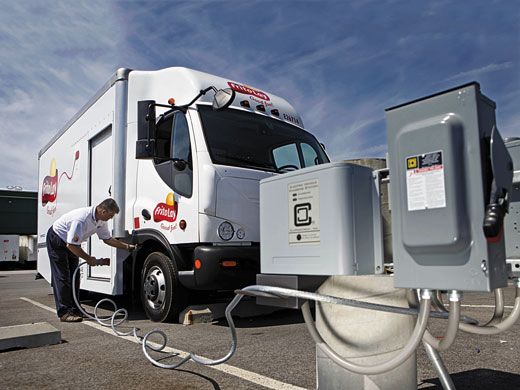Forget the Volt, Make Way for Electric Trucks
Smith trucks are powered by batteries, not diesel, which could make a big difference in the fight against climate change
/https://tf-cmsv2-smithsonianmag-media.s3.amazonaws.com/filer/Phenom-electric-trucks-631.jpg)
When you press the accelerator of a Smith truck, it moves forward briskly, smoothly and in eerie quiet.There are no tailpipe emissions, because there is no tailpipe, and no tank for gas or diesel. Smith trucks are powered by batteries—the same technology, basically, that General Motors, Toyota and a handful of start-up companies are struggling to bring to a mass market in automobiles. When and if they get there, they will find—if Smith CEO Bryan Hansel is correct—a fleet of hundreds of thousands of electric trucks already on the road.
The electric car, despite its enormous advantages in operating cost, efficiency, environmental impact and social cachet, suffers from a chicken-and-egg dilemma: Customers are reluctant to buy them if they can’t get them recharged on the road, and nobody is going to build charging stations until there’s a critical mass of vehicles to use them. Hansel, a serial entrepreneur whose last business manufactured respiratory equipment for home use, realized that this didn’t have to be a problem for so-called “medium-duty” trucks—the roughly 3.3 million vans that shuttle every day among warehouses, distribution centers, retail stores, homes and offices, delivering everything from overnight letters to cases of soda. “People look at an electric car and it sounds great at first, it goes 50 miles on a charge and they only drive 15 miles each way to work. But then they think, well, on the weekend I want to visit Grandma, and that’s a 100-mile round trip,” he says. But “these trucks never go to Grandma. Every night they’re back in the garage, and the next morning they’re charged up and ready to go.”
Hansel’s company, which plans to build around 390 trucks this year at a small plant in Kansas City, Missouri, began in 2009 as the American licensee of the venerable English firm of the same name, which built milk trucks with electric motors for quiet predawn deliveries. Last year Hansel bought out the parent company’s business; he is building a second factory in New York City and hopes eventually to have as many as 20 around the country, putting them close to customers such as FedEx and Frito-Lay. He wants to entrench his company in key markets before others wake up to the potential.
Here is Hansel’s pitch, in a nutshell: Electric motors are powerful (they propel locomotives, after all), efficient (no waste heat or cooling system) and relatively maintenance-free (Hansel asks: “Do you have any idea what a company like Frito-Lay spends on mufflers?”). And they emit no pollution. Of course, they use electricity, most of which is generated by burning fossil fuels. But as power plants rely more on renewable sources such as wind and solar, electric trucks look better and better. Averaged over the entire country, and taking into account regional differences, Smith calculates that each truck it sells reduces greenhouse gas emissions by 85 percent, compared with diesel.
The technological challenge of our age is to generate, store and move power with maximum efficiency. Or—to put it in more concrete terms—to get a case of potato chips from the distribution center to the grocery store using the least amount of energy. The electric truck has the power to do that—and, if it proves itself, the power to transform a large part of our economy.
